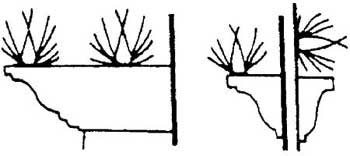
-
Detection. Several specific signs are associated with rodent infestation:
- Urine. House mice urinate at intervals along well-used runways, occasionally creating small mounds (urinating pillars) that consist of a combination of grease, urine and dirt that fluoresces under ultraviolet (black) light.
- Smudges or rub marks. Dirt and oil from the fur of the rodent may sometimes leave smudge marks on pipes and beams. Smudge marks left by rats are much more conspicuous than those produced by house mice.
- Gnawing marks. Sawdustlike wood chips are produced by the gnawing of house mice and rats around baseboards, doors, windows and frames, and kitchen cabinets. Recent gnawings on wood are light in color, darkening with age. The size of the tooth marks left in the wood can help distinguish the presence of rats or mice.
- Droppings. The age of the droppings indicates whether the infestation is current. Old droppings are dry, gray and crumble easily when pressed. Fresh droppings are dark and moist. Droppings are most numerous along runways, near burrow entrances and at feeding sites.
- Pet excitement. Pawing and excitement of cats and dogs can indicate the presence of rodents. Pets respond most commonly when the premises have been invaded only recently. Odor. Rodents produce characteristic odors. With experience, the musky scent of house mice can be differentiated from those produced by rats.
- Runways. Rats and mice are creatures of habit and will travel the same pathways between their shelter, food and water sources. Outside these appear as packed earth paths; they are also evident in dense vegetation. Indoors, runways are usually along walls, under boards, behind stored objects and similar places.
- Tracks. Fresh tracks are distinct, old ones faint. Tracks are more easily seen by side illumination with a flashlight than by direct light from above. Tail drags, as well as footprints, may show up. A smooth patch of flour or talc laid down in a runway may show activity.


 |

- Spikes (porcupine wire, sharp metal spikes or any similar "bed of nails") can stop birds from roosting on ledges. Where they can be used, they usually work fairly well. If aesthetics are important, these devices can be limited to areas where they cannot be easily seen. If pigeons are likely to drop nest material and other debris on the newly installed spikes in an attempt to create a new roosting surface, install metal spikes on potential landing sites above the installation. Check every six months for accumulated debris or nest material, regularly remove leaves and other matter and ensure that no tree branches hang over protected ledges.
- Netting blocks access of birds to large roosting areas in structures, especially in warehouses and around mechanical equipment areas and cooling towers where aesthetics are of minor consideration. Knotted or extruded, UV-resistant plastic nets will last two to five years.
- Covers or ramps custom-designed for ledges, window air-conditioning units and roof edges keep birds from infesting these sites. This is costly but valid where limited application will keep birds off selected sites and where aesthetics are an important consideration.
-
Several factors are involved in the successful placement of baits:
- Placement should be on a site where the birds are accustomed to feeding — if safe and practical.
- Place in a natural manner, scattered rather than containerized or piled.
- Place baits at a time when the birds cannot observe the baiting activity, or if not possible, use the same person and routine each time.
- Pre-bait when unfamiliar food or a container is used and when a fast-acting poison is used.
University of Florida and the American Mosquito Control Association
Public Health Pest Control WWW site at http://entomology.ifas.ufl.edu/fasulo/vector/
Additional Resources:
- The Internet Center for Wildlife Damage Management
- UF - Online Guide to the Snakes of Florida
- UF/IFAS - Bats
- UF/IFAS - Dealing with Snakes in Florida's Residential Areas
- UF/IFAS - Opossums
- UF/IFAS - Raccons
- UF/IFAS - Squirrels
- UF/IFAS - Trapping the Nine-banded Armadillo
Return to Public Health Pest Control Menu
http://entomology.ifas.ufl.edu/fasulo/vector/